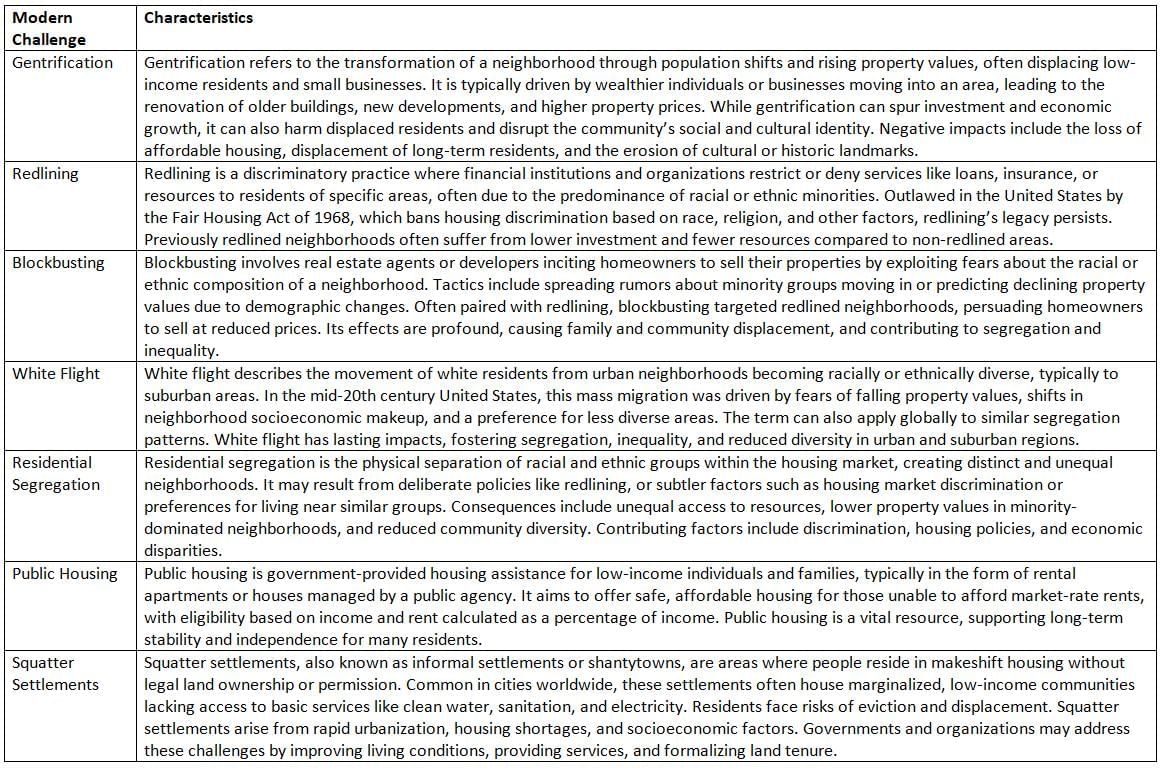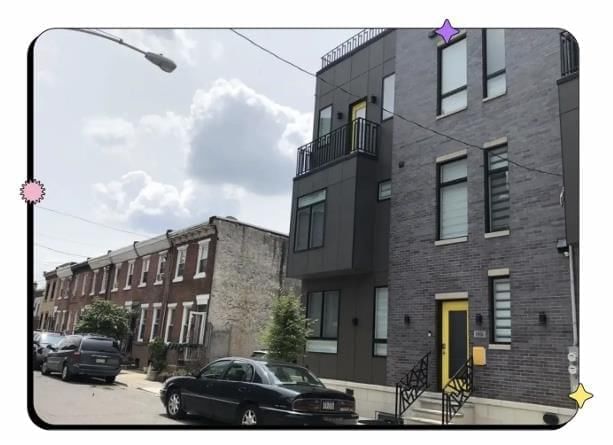Challenges of Urban Changes Chapter Notes | AP Human Geography - Grade 9 PDF Download
Introduction
Urbanization, the process by which a growing share of a population resides in urban areas, brings significant transformations to cities and regions. These changes can yield both positive and negative impacts on the social, economic, and environmental well-being of communities.
Key challenges associated with urban change include:
- Housing affordability: Rapid urban growth can drive up housing costs, making it challenging for low- and middle-income families to secure affordable living spaces.
- Inequality: Urbanization can widen income disparities, with wealthier groups benefiting more from urban opportunities and amenities, while poorer residents struggle to access basic necessities like affordable housing.
- Traffic congestion: Increased urban populations can lead to greater traffic congestion, negatively affecting air quality and overall quality of life.
- Environmental degradation: Urban expansion can strain natural resources and contribute to environmental harm, such as the loss of green spaces and increased waste production.
To tackle these issues, governments and community organizations may adopt policies and initiatives to foster sustainable urban development, including providing affordable housing, promoting public transportation, and safeguarding natural resources.
Challenges

Problems
Urban communities’ growth and decline are associated with various social and economic challenges, including housing and insurance discrimination, housing affordability issues, limited access to food stores and public services, disamenity zones, and gentrification.
Disamenity Zones
- Disamenity zones are urban areas lacking desirable features, often marked by high pollution, traffic congestion, crime, or poverty, making them less appealing for residence.
- These zones negatively affect residents’ health, well-being, and quality of life, contributing to social and economic inequality. Governments and community groups may address these issues through initiatives to enhance public safety, reduce pollution, and improve access to amenities and services.
- In the United States, historical racial discrimination, whether through legal (de jure) or informal (de facto) means, was perpetuated by segregated urban development, known as residential segregation.
De Jure or De Facto
- De jure and de facto are Latin terms distinguishing between legally mandated (de jure) and informally existing (de facto) conditions.
- De jure segregation refers to segregation enforced by laws or official policies. For instance, racial segregation in U.S. public schools before the 1954 Brown v. Board of Education ruling, which deemed it unconstitutional, was de jure segregation.
- De facto segregation occurs due to social, economic, or cultural factors, not explicit laws. It may stem from residential patterns, job market dynamics, or other factors separating groups within a population.
- Both forms of segregation can limit opportunities and well-being for disadvantaged groups, exacerbating social and economic inequality. Governments and organizations may combat segregation through fair housing policies, targeted economic development, and education reforms.
- Blockbusting is a discriminatory practice where real estate agents pressure homeowners to sell by exploiting fears of minority groups moving into a neighborhood, then use fear tactics to prompt others to sell at low prices.
- Central cities lost prominence in the 1980s but regained popularity in the 1990s, becoming cultural and entertainment hubs. However, rising housing costs and limited availability in desirable areas pushed people to seek affordable housing elsewhere. Gentrification involves renovating old structures in declining areas, transforming low-income neighborhoods into middle- and high-income ones. While it boosts local economies, it raises property values, displacing poorer, often minority residents who settled there during redlining and blockbusting eras. Gentrification creates tensions between long-term residents and newcomers. In some cases, abandoned areas are entirely demolished. The image below contrasts a gentrified area (right) with the original neighborhood (left).

- As cities decentralize by relocating industries outward, residents also leave through a process called counter-urbanization. Some move to suburbs, while others relocate to rural areas. About one in six Americans lives in a master-planned community, many of which include gated subsets enclosed by walls or fences with restricted access. Over 9 million high-income Americans reside in such gated communities, seeking safety from inner-city crime. Gated communities exist globally as well.
Key Terms
- Blockbusting: Blockbusting is a discriminatory real estate tactic where agents induce homeowners to sell at low prices by stoking fears about racial or ethnic minorities moving into a neighborhood, historically contributing to segregation and urban decline, reflecting housing market challenges.
- Counter-urbanization: Counter-urbanization is the migration of people from urban to rural areas, often in pursuit of better quality of life, lower costs, or tranquility. It challenges urban dynamics by reducing city populations while increasing rural growth, impacting infrastructure and services.
- De Jure Segregation: De jure segregation is the legal separation of groups based on race, ethnicity, or religion through laws or policies, affecting urban communities by limiting access to resources and opportunities, perpetuating inequality.
- De Facto Segregation: De facto segregation is the separation of groups due to social, economic, or cultural factors, not laws, manifesting in urban housing patterns, school districts, and neighborhoods, leading to unequal resource access.
- Disamenity Zones: Disamenity zones are urban areas with undesirable conditions like poverty, crime, or pollution, resulting from urbanization and wealthier groups moving to affluent areas, leaving marginalized communities with limited services.
- Environmental Degradation: Environmental degradation is the decline of natural resources like air, water, and soil, and loss of ecosystems, driven by population growth, urbanization, and unsustainable economic practices.
- Gated Communities: Gated communities are enclosed residential areas with controlled access, offering security and amenities, reflecting urban development trends and socioeconomic stratification through exclusive living environments.
- Gentrification: Gentrification is the transformation of low-income neighborhoods through wealthier residents’ influx, raising property values and displacing original residents, impacting urban socioeconomic and cultural dynamics.
- Housing Affordability: Housing affordability is the ability to pay for housing without compromising other needs, critical for urban dynamics, as rising costs drive displacement, gentrification, and homelessness.
- Inequality: Inequality is the unequal distribution of resources, opportunities, and privileges, manifesting in economic and social disparities, posing challenges for urban sustainability and growth.
- Master-planned Community: A master-planned community is a comprehensively designed residential area with mixed housing, commercial spaces, and amenities, promoting walkability and sustainability to address urban sprawl challenges.
- Public Housing: Public housing is government-funded housing for low-income families, aimed at reducing homelessness and poverty, playing a key role in urban planning and addressing socioeconomic issues.
- Redlining: Redlining is a discriminatory practice denying services like loans or insurance to residents of minority-dominated areas, shaping urban development and perpetuating economic and social inequities.
- Residential Segregation: Residential segregation is the separation of racial, ethnic, or socioeconomic groups in urban housing, leading to unequal access to resources and reinforcing social disparities.
- Squatter Settlements: Squatter settlements are informal urban areas where residents build homes without legal rights, lacking basic services, reflecting challenges of rapid urbanization and housing shortages.
- Traffic Congestion: Traffic congestion is the overcrowding of vehicles on roads, causing delays and impacting urban mobility, economic productivity, and environmental sustainability.
- Urbanization: Urbanization is the increasing proportion of people living in urban areas, driving social, economic, and environmental changes, affecting demographics, infrastructure, and cultural dynamics.
- White Flight: White flight is the migration of white residents from diversifying urban neighborhoods to suburbs, driven by racial or economic concerns, impacting urban segregation and development.
FAQs on Challenges of Urban Changes Chapter Notes - AP Human Geography - Grade 9
| 1. What are some common challenges faced by urban areas due to rapid population growth? |  |
| 2. How does urbanization impact the environment? |  |
| 3. What are some strategies cities can implement to manage urban challenges effectively? |  |
| 4. What role does government policy play in addressing urban change challenges? |  |
| 5. Why is community involvement important in urban development? |  |




















